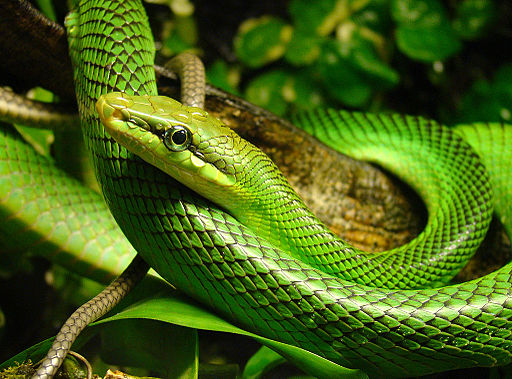Superregnum: Eukaryota
Regnum: Animalia
Subregnum: Eumetazoa
Cladus: Bilateria
Cladus: Nephrozoa
Superphylum: Deuterostomia
Phylum: Chordata
Cladus: Craniata
Subphylum: Vertebrata
Infraphylum: Gnathostomata
Superclassis: Tetrapoda
Cladus: Reptiliomorpha
Cladus: Amniota
Classis: Reptilia
Cladus: Eureptilia
Cladus: Romeriida
Subclassis: Diapsida
Cladus: Sauria
Infraclassis: Lepidosauromorpha
Superordo: Lepidosauria
Ordo: Squamata
Subordo: Serpentes
Infraordo: Caenophidia
Superfamilia: Colubroidea
Familia: Colubridae
Subfamilia: Colubrinae
Genus: Gonyosoma
Species: Gonyosoma oxycephalum
Name
Gonyosoma oxycephalum (Boie, 1827)
Type locality: Indonesia: Java.
Synonyms
Coluber oxycephalus Boie, 1827
Gonyosoma viride Wagler, 1828
Herpetodryas oxycephalus - Schlegel, 1837: 152
Alopecophis chalybeus Gray, 1849: 247
Gonyosoma oxycephalus - Bleeker, 1857
Aepidea robusta Hallowell, 1861
Coluber oxycephalus - Boulenger, 1890
Coluber oxycephalus - Boulenger, 1894: 56
Elaphe oxycephala - Griffin, 1909
Gonyosoma oxycephala - Barbour, 1912
Elaphe oxycephala oxycephala - Sackett, 1940
Elaphe oxycephala — Smith, 1943: 144
Coluber jansenii (nec Gonyosoma jansenii Bleeker, 1858) - Robinson & Kloss, 1920
Gonyosoma oxycephalum — Dowling, 1958
Gonyosoma oxycephalum — Trutnau, 1986
Elaphe oxycephala — Schulz, 1996
Gonyosoma oxycephalum — Manthey & Grossmann, 1997: 355
Gonyosoma oxycephalum — Cox et al., 1998: 53
Gonyosoma oxycephala — Gaulke, 2001: 32
Gonyosoma oxycephala — Ferner et al., 2001
Elaphe oxycephala — Sharma, 2004
References
Boie, F. 1827. Bemerkungen über Merrem's Versuch eines Systems der Amphibien, 1. Lieferung: Ophidier. Isis van Oken, Jena, 20: 508–566.
Dowling, Herndon G. 1958. A taxonomic study of the ratsnakes VI. Validation of the genera Gonyosoma Wagler and Elaphe Fitzinger. Copeia 1958 (1): 29–40.
Ferner, John W., Rafe M. Brown, Rogelio V. Sison and Robert S. Kennedy 2001. The amphibians and reptiles of Panay Island, Philippines. Asiatic Herpetological Research. 9: 34–70.
Gonyosoma oxycephalum at the New Reptile Database. Accessed on 13 sep 2008.
Vernacular names
English: Red-tailed Green Ratsnake
Bahasa Indonesia: Ular bajing
Gonyosoma oxycephalum, known commonly as the arboreal ratsnake, the red-tailed green ratsnake, and the red-tailed racer, is a species of snake in the family Colubridae. The species is endemic to Southeast Asia.
It was first described by Friedrich Boie in 1827.[2]
Description
G. oxycephalum is a robust powerful snake, with wide smooth scales on its belly that are ideal for climbing trees and across branches. It has smaller, smooth scales on its back, which is usually bright green or light green and may have a black net-like pattern. A gray-colored morph with a yellow head exists in Panay, in the Philippines.
As some of its common names indicate, the snake has a green body with a red tail, but is usually brown. It also has a dark line horizontally across the eye. On the sides of its black tongue there may be brown and blue colour. The top of the head may be dark green, yellow-green, or yellow in colour.
Gonyosoma oxycephalum, Kaeng Krachan National Park, Thailand
Gonyosoma oxycephalum
The female can reach a length of up to 2.4 m (almost 8 feet), while the male is generally a little bit smaller but brighter in coloration.
Longevity
The average life span of G. oxycephalum in captivity is 20 years.
Reproduction
G. oxycephalum reaches sexually maturity at 4 years of age, and its eggs have a hatching time from 13 to 16 weeks. The female lays on average between 3 and 8 eggs usually between September and January and the hatchlings are about 45 cm (18 inches) long.
Behavior
The red-tailed green ratsnake lives and spends its life in the trees and in cavities of trees. It seldom descends to the ground. When the snake is stressed, it may inflate a bag of air in its neck, making it appear larger in size.
In captivity, it has quite the "attitude" and may strike at or bite an unwary handler. Its temperament can be unpredictable and may change from time to time but an individual may become tame through proper handling.
Diet
G. oxycephalum feeds almost exclusively on birds, bird eggs, lizards, and bats. It catches them in mid-air while hanging amongst branches. In captivity, it can be trained to feed on rodents such as mice and rats.
Distribution
G. oxycephalumm is found in the following countries:
Indonesia (Bangka, Belitung, Java, Kalimantan/Borneo, Karimata, Legundi, Lombok, Mentawai islands, Natuna islands, Nias, Panaitan, Riau archipelago, Sebuku, Sumatra, Tambelan archipelago),
Malaysia (Malaya and East Malaysia, Pulau Tioman ?),
Singapore Island, Penang Island,
India (Andaman Islands),
Myanmar,
Thailand (incl. Phuket), Cambodia, Laos, Vietnam,
Philippine Islands (Balabac, Bohol, Catanduanes, Lubang, Luzon, Negros, Palawan, Sulu Archipelago, Panay).
The Type locality is Indonesia: Java (F. Boie, 1827).
References
Wogan, G.; Vogel, G.; Thy, N.; Nguyen, T.Q.; Demegillo, A.; Diesmos, A.C.; Gonzalez, J.C. (2012). "Gonyosoma oxycephalum". IUCN Red List of Threatened Species. 2012: e.T183196A1732988. doi:10.2305/IUCN.UK.2012-1.RLTS.T183196A1732988.en. Retrieved 19 November 2021.
Boie, F. (1827). "Bemerkungen über Merrem's Versuch eines Systems der Amphibien, Erste Lieferung: Ophidier". Isis von Oken. 20 (VI): 508–566.
Further reading
Boulenger GA (1894). "On the Herpetological Fauna of Palawan and Balabac". Ann. Mag. Nat. Hist., Sixth Series 14: 81–90.
Dowling, Herndon G. (1958). "A taxonomic study of the ratsnakes VI. Validation of the genera Gonyosoma Wagler and Elaphe Fitzinger". Copeia 1958 (1): 29–40.
Gray JE (1849). "Description of three new genera and species of snakes". Ann. Mag. Nat. Hist., Second Series 4: 246–248.
Retrieved from "http://en.wikipedia.org/"
All text is available under the terms of the GNU Free Documentation License


